|
Field trip, 1st day
Rosia Montana
20th october 2003.
Introduction
There is a territory in
Transsylvania where since the prehistoric age active mining has been
going on. The territory between the villages Rosia Montana, Brad, Sacaramb
and Zalatna is also called "gold-quadrangle". At present there
isn't intensive mining, but there still are significant ore occurences
in this area, which the canadian Rosia Montana Gold Corporation (Gabriel
Resources Ltd.) is planning to work out.
Knowing that there is intensive research going on in the area, we thought
it would be interesting and instructive to see a serious exploration.
Dr. Ferenc Molnár, the SC sponsor of the Department of Mineralogy
got in touch with Garry O'Conor, the research-leading geologist, who
gave a favourable answer to our request. 16 students of the SC, Dr.
Ferenc Molnár, and Dr. Tibor Zelenka, the acadamic SC sponsor
took part on the field trip.
19th
october: Travel Budapest-Déva
We traveled on the 19th
october from Budapest trough Oradea and Brad to Déva .In the
evening we stayed in the guesthouse of the Calvinist community. Right
in that evening Cecília Szentesy and István Márton,
the chief geologists of the Gabriel Resources Ltd. visited us and gave
an interesting lecture about the past, present and future of the researches.They
also guided us both days on the field and told us many exciting stories
about the mines, researches and the inhabitants of the area. We want
to give them our special thanks for their help again.

Theoretical preparing in the restaurant of the calvinist
guesthouse.
 Rosia Montana (Verespatak), 20th october 2003.
Rosia Montana (Verespatak), 20th october 2003.
The Au-polymetallic and Au-telluride ore deposits
connected to the neogene vulcanism in the transsylvanian ore-mountains
(Rosia Montana and surroundings).
In the territory of the
transsylvanian Munti Metaliferi, the neogene vulcanism went on in three
main periods between the badeni and the pleistocene. The beginning of
the first period is characterized by riodacite-dacite. The main part
of the first period is built up by calc-alkalic amphibole-pyroxene dacites
and andesites. The vulcanism was mainly explosive, but two intrusions
(14,8-11 Ma) are also known in the area of Zaránd-Brad-Zalatna-Rosia
Montana, and Déva-Brad-Rosia Montana The intrusive bodies are
amphibole and pyroxene-andesites, which are accompanied by diatreme
breccia domes (pipes).
The age of the second magmatism is 12,6-11 Ma, and it is characterized
by quartz-andesites. The centre of the vulcanism can be located to the
area of Déva-Sacaramb-Rosia Montana. Smaller trachiandesite,
microdiorite and abasaltic bodies were formed in this period.
The final stage of the magmatism produced alcalic vulcanites.
The magmatism was generated by the transtensious fault system, which
formed small pull-apart basins on the Tisza-Géta terrene. Because
of the extension deep fault systems had came into being, which became
the directing chanels of the magmas.The extensional tectonical regime
advanced the formation of intrusions and Cu-porphyric systems. Above
the Cu-porphyric bodies HS- and LS-type epithermal systems developed,
which formed gold- and silver-rich ore bodies. We can find Au-polymetallic
or Au-telluride ore occurences. The ore is situated in propylitisated
riodacite-andesite domes, breccias and dykes of NW-SE direction. The
typical minerals of the ore bodies are quartz, calcite, barite, rodochrosite,
gray copper ores, sulphosalts, pyrite, sphalerite, chalcopyrite, arsenopyrite,
galenite, antimonite.
In 1778 Pál Kitaibel discovered Tellure (Te) in the Au-tellurides
of this area.
1st stop: Gabriel Resources research centre
After having breakfast we traveled to Rosia Montana, which
lies high above sea level. In Rosia Montana in the centre of the company
Garry O' Connor welcomed us with tea and coffee.
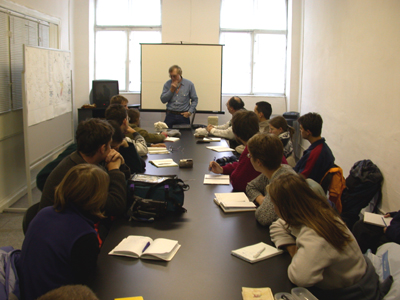
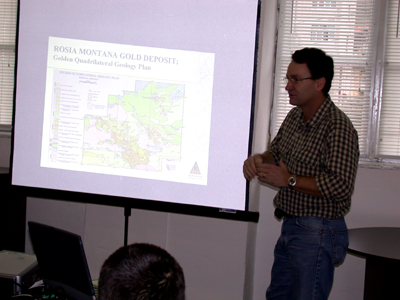
Garry O' Connor gives a lecture about the geology of
the ore-mountains
After we got warm, Garry gave us a lecture about the geology
of the area, and about the researches. He told us also about the rocks,
typical ore minerals and the environmental questions. The biggest opponents
of mining are the "greens". The mining has caused much soiling
of the nature, and the company promised to make disappear the former
and his own soilings of the past. After the presentasions we had a look
at the little exhibition in the entrance-hall, which introduces us the
history of the village, and shows the archeological results.
2nd stop: Cetate open cast mine
We sat into the jeeps of the company and drove up to the first
open cast mine (Cetate). The firm does its main exploration at this
place. The roumanian state is mining still right know (with defficite)
in this quarry.
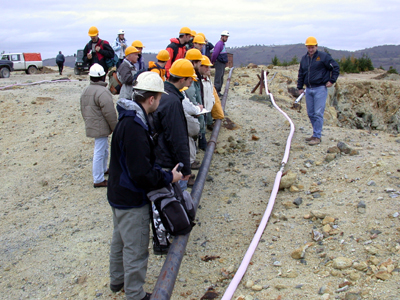
Field orientation. In back with white hat Cecília
Szentesy, in front István Márton. Garry O'Connor is presenting..
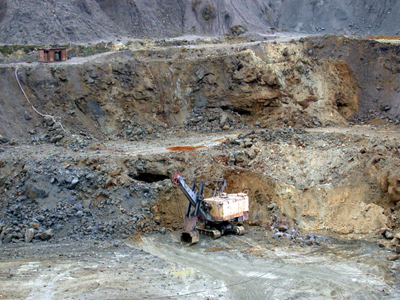
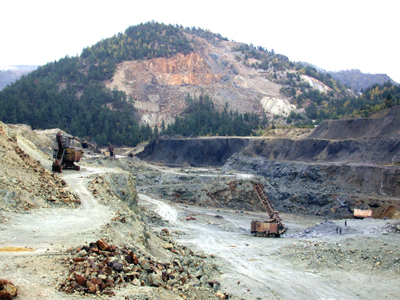
The roumanian mining in october 2003 in Rosia Montana.
The black rocks are organic material-bearing refuse breccias
3rd stop: Cetate open cast mine, phyllic zone
In the outcrop we saw silicified- phyllic altered daciteporphyr
containing huge, up to some centimeter big hexagonal quartz crystals.
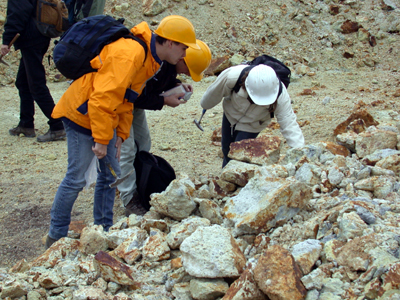

Student Chapter members at work...
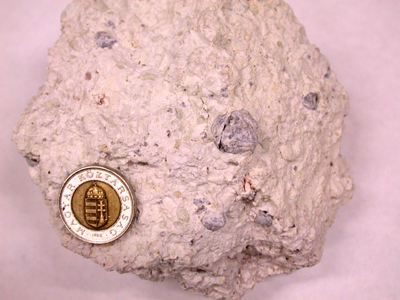
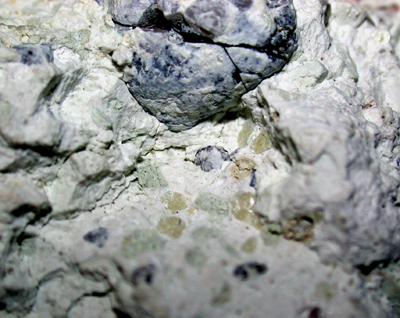
Phyllic daciteporphyr with hexagonal quartz crystals
4th stop: Cetate open cast mine, breccia-zone with quartz-adularia-pyrite
alteration

Dr. Tibor Zelenka examines an extremely silicified breccia-zone

Brecciated, silicified daciteporphyr block

Quartz-pyrite veins in brecciated,silicified daciteporphyr
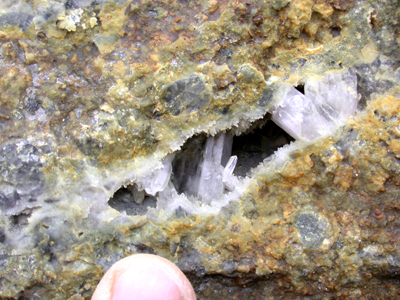
Grown-up quartz crystals in the silicified daciteporphyr
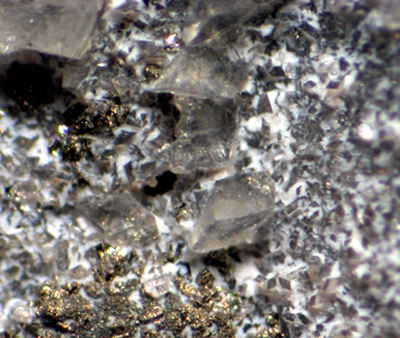
Idiomorphic clear adularia crystals with pyrite and illite
(white). The adularia can be found in two sizes, the fine-grained give
the "carpet".

Adularia crystals (~3 mm picture width)
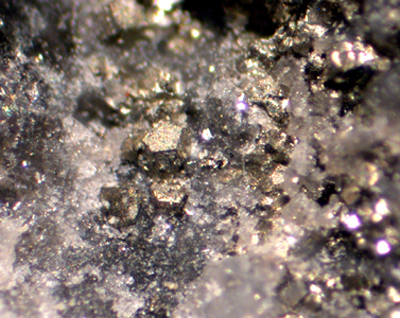
Solitary euhedral pyrite crystals (~3 mm picture width)
5th stop: Crinic diatreme pipe
The breccias are often dark because of the organic materials
they have taken with them. The material of the breccias is polymict;
they contain clasts of the vulcanic rocks as well as carbonatic and
crystalline rocks. They are refuse, despite of their rich pyrite and
adularia content. Driving further with the jeep we could see the entrances
of many mediaeval adits.
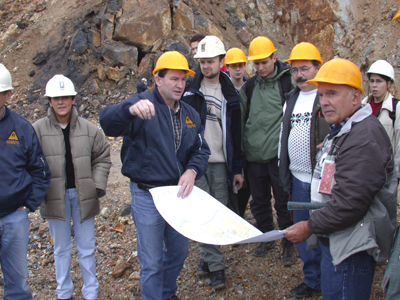

Panorama-picture of the Cetate open cast mine from Crinic
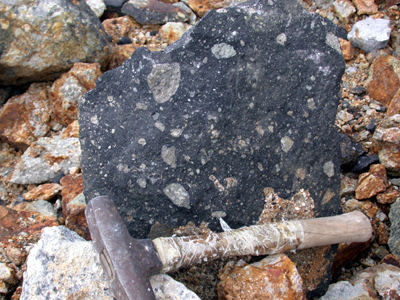

Polymict organic material-containing diatreme breccia
pipe
6th stop: Crinic, south of the working area
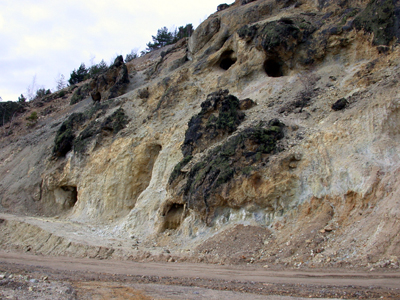
Entrances of mediaeval adits
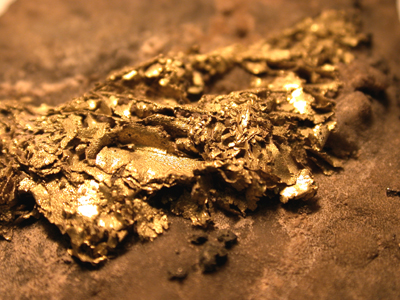
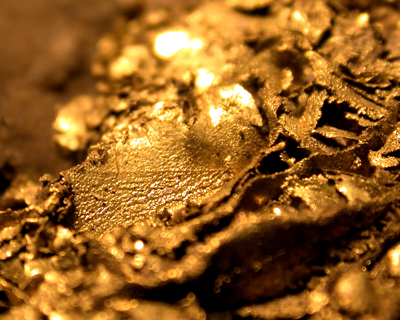
The well crystallized tabular native gold was
very frequent during former mining. The picture was taken from 2 cm.
The native gold on the picture can be found in the mineral exhibition
of the Department of Mineralogy at the Eötvös University.
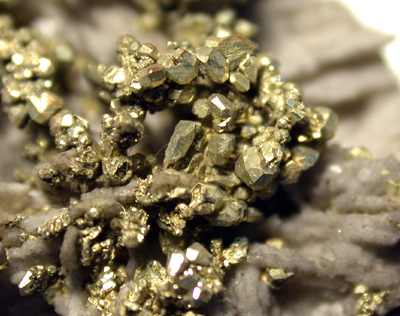
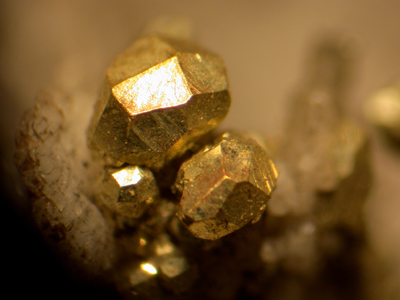


Rosia Montana, the most famous site of grown-up native
gold. The gold crystals are grown-up on thin calcites.
The native gold on the picture can be found in the mineral exhibition
of the Department of Mineralogy at the Eötvös University
At the last stop in Rosia Montana, we could also see
fresh, not altered dacite. Going back to the village we saw the houses
vacated because of mining, and the church which will also be moved.
7th stop: Abrud, drilling core shack
The drilling core shack of the researching company can be found
in Abrud. The cores are halved, and geologists describe the textural,
mineralogical and structural features of the cores, so establishing
a huge database. After this technicians take average samples of the
core at definite distances. They pulverize the samples and melt a definite
quantity in a furnace at 1400 degrees. On the bottom of the melt leadregulus
formes, from which they vaporize the lead, and after proper mineral
water attacking, gold, silver and platina-metals can be identified with
the help of a spectroscopic method (for example: flame phothometry).
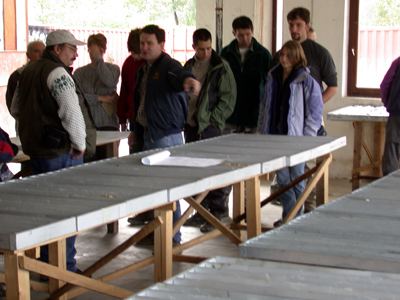
Drilling cores waiting for examination
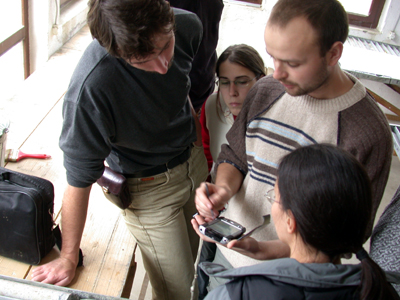
István Márton introduces us the use of
a mini computer
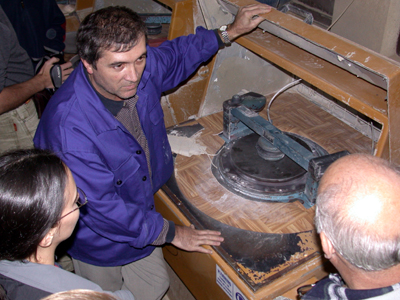
Geochemical investigation. Pulverization of the core-material...
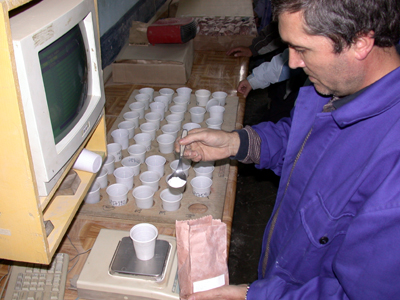
...measuring in a definied quantity..
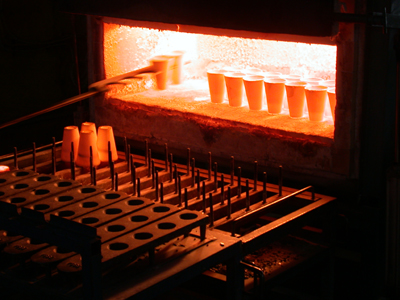
...melting of the pulver...

...pouring out and cooling of the melt...
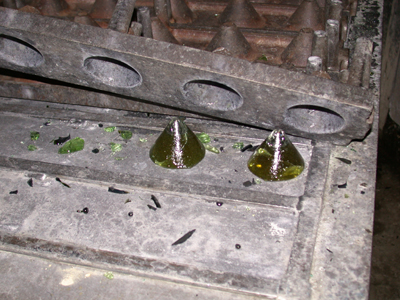
...the alloy of gold, silver and platina-metals precipitate
on the bottom of the vitrified rockpulver…
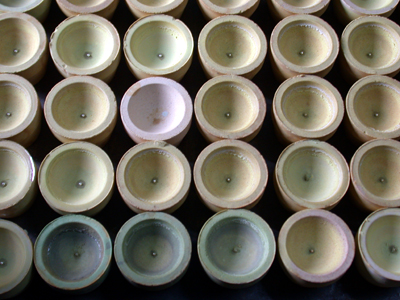
...after vaporizing the lead only the tiny Au-Ag-PGE
balls remain...
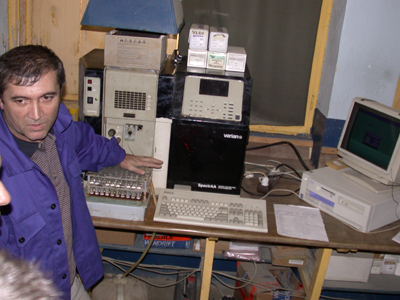
...and finally the examination reveals us how big the
gold-concentration of the given core-sample is.
8th stop: The Bucium area
From Rosia Montana we drove to Bucium, which is another
research area of the company. There isn't any profitably exploitable
gold-ore at the moment in this territory, but if the mining starts in
Rosia Montana, this territory will also become profitable.
After the long and exhausting field day we returned to Deva, where we
were surprised by the company and they waited us with lunch in the restaurant
of the guesthouse.

Garry O'Connor introduces us the Bucium area with help
of a geological map

The Bucium area
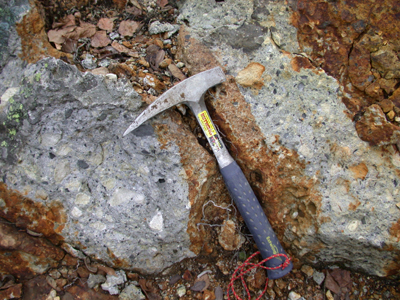
Phyllic breccia at Bucium
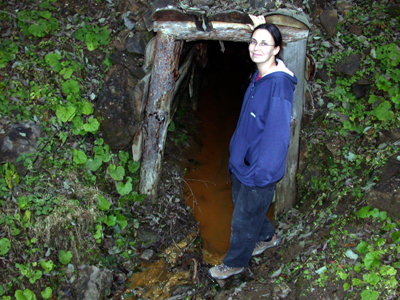
The entrance of the mediaeval Konkordia mine in Bucium
|

 Rosia Montana (Verespatak), 20th october 2003.
Rosia Montana (Verespatak), 20th october 2003. 






































